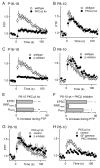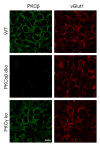Calcium-dependent PKC isoforms have specialized roles in short-term synaptic plasticity
- PMID: 24794094
- PMCID: PMC4097165
- DOI: 10.1016/j.neuron.2014.04.003
Calcium-dependent PKC isoforms have specialized roles in short-term synaptic plasticity
Abstract
Posttetanic potentiation (PTP) is a widely observed form of short-term plasticity lasting for tens of seconds after high-frequency stimulation. Here we show that although protein kinase C (PKC) mediates PTP at the calyx of Held synapse in the auditory brainstem before and after hearing onset, PTP is produced primarily by an increased probability of release (p) before hearing onset, and by an increased readily releasable pool of vesicles (RRP) thereafter. We find that these mechanistic differences, which have distinct functional consequences, reflect unexpected differential actions of closely related calcium-dependent PKC isoforms. Prior to hearing onset, when PKCγ and PKCβ are both present, PKCγ mediates PTP by increasing p and partially suppressing PKCβ actions. After hearing onset, PKCγ is absent and PKCβ produces PTP by increasing RRP. In hearing animals, virally expressed PKCγ overrides PKCβ to produce PTP by increasing p. Thus, two similar PKC isoforms mediate PTP in distinctly different ways.
Copyright © 2014 Elsevier Inc. All rights reserved.
Figures









Similar articles
-
Adaptive regulation maintains posttetanic potentiation at cerebellar granule cell synapses in the absence of calcium-dependent PKC.J Neurosci. 2012 Sep 19;32(38):13004-9. doi: 10.1523/JNEUROSCI.0683-12.2012. J Neurosci. 2012. PMID: 22993418 Free PMC article.
-
Calcium-dependent isoforms of protein kinase C mediate posttetanic potentiation at the calyx of Held.Neuron. 2011 Jun 9;70(5):1005-19. doi: 10.1016/j.neuron.2011.04.019. Neuron. 2011. PMID: 21658591 Free PMC article.
-
Calcium-Dependent Protein Kinase C Is Not Required for Post-Tetanic Potentiation at the Hippocampal CA3 to CA1 Synapse.J Neurosci. 2016 Jun 15;36(24):6393-402. doi: 10.1523/JNEUROSCI.0708-16.2016. J Neurosci. 2016. PMID: 27307229 Free PMC article.
-
The calyx of Held synapse: from model synapse to auditory relay.Annu Rev Physiol. 2012;74:199-224. doi: 10.1146/annurev-physiol-020911-153236. Epub 2011 Oct 24. Annu Rev Physiol. 2012. PMID: 22035348 Review.
-
Isoform specificity of protein kinase Cs in synaptic plasticity.Learn Mem. 2007 Apr 2;14(4):236-46. doi: 10.1101/lm.469707. Print 2007 Apr. Learn Mem. 2007. PMID: 17404386 Review.
Cited by
-
Apoer2-ICD-dependent regulation of hippocampal ribosome mRNA loading.Res Sq [Preprint]. 2023 Jun 28:rs.3.rs-3040567. doi: 10.21203/rs.3.rs-3040567/v1. Res Sq. 2023. Update in: Mol Neurodegener. 2023 Sep 19;18(1):62. doi: 10.1186/s13024-023-00652-1. PMID: 37461529 Free PMC article. Updated. Preprint.
-
Molecular Machines Regulating the Release Probability of Synaptic Vesicles at the Active Zone.Front Synaptic Neurosci. 2016 Mar 2;8:5. doi: 10.3389/fnsyn.2016.00005. eCollection 2016. Front Synaptic Neurosci. 2016. PMID: 26973506 Free PMC article. Review.
-
Regulation of the hippocampal translatome by Apoer2-ICD release.Mol Neurodegener. 2023 Sep 19;18(1):62. doi: 10.1186/s13024-023-00652-1. Mol Neurodegener. 2023. PMID: 37726747 Free PMC article.
-
Monocular Deprivation Affects Visual Cortex Plasticity Through cPKCγ-Modulated GluR1 Phosphorylation in Mice.Invest Ophthalmol Vis Sci. 2020 Apr 9;61(4):44. doi: 10.1167/iovs.61.4.44. Invest Ophthalmol Vis Sci. 2020. PMID: 32343785 Free PMC article.
-
Dynamin-1 deletion enhances post-tetanic potentiation and quantal size after tetanic stimulation at the calyx of Held.J Physiol. 2017 Jan 1;595(1):193-206. doi: 10.1113/JP271937. Epub 2016 Jun 27. J Physiol. 2017. PMID: 27229184 Free PMC article.
References
-
- Abbott LF, Regehr WG. Synaptic computation. Nature. 2004;431:796–803. - PubMed
-
- Abeliovich A, Chen C, Goda Y, Silva AJ, Stevens CF, Tonegawa S. Modified hippocampal long-term potentiation in PKC gamma-mutant mice. Cell. 1993;75:1253–1262. - PubMed
-
- Bao JX, Kandel ER, Hawkins RD. Involvement of pre- and postsynaptic mechanisms in posttetanic potentiation at Aplysia synapses. Science. 1997;275:969–973. - PubMed
-
- Barclay JW, Craig TJ, Fisher RJ, Ciufo LF, Evans GJ, Morgan A, Burgoyne RD. Phosphorylation of Munc18 by protein kinase C regulates the kinetics of exocytosis. J Biol Chem. 2003;278:10538–10545. - PubMed
Publication types
MeSH terms
Substances
Grants and funding
LinkOut - more resources
Full Text Sources
Other Literature Sources
Molecular Biology Databases
Research Materials

